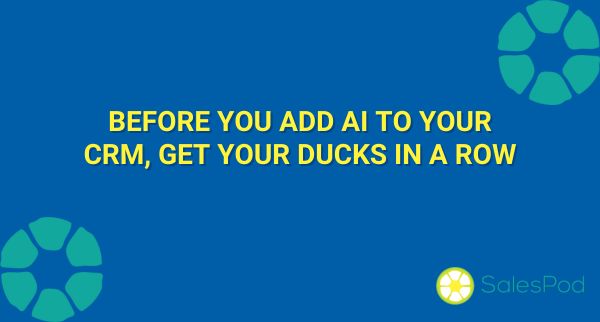Everyone’s talking about AI-powered CRMs right now. Systems that automatically log emails, predict who’s most likely to buy, and even tell you the best time to follow up.
It sounds amazing. And it is, for businesses that have their house in order.
But for most small and mid-sized businesses, the reality looks a bit different. The CRM might be full of half-entered notes, duplicate contacts, and gaps in deal history. If that’s you, adding AI won’t suddenly fix the problem. In fact, it can make it worse.
Because AI can’t make sense of chaos. If your CRM data’s a mess, AI just gives you faster bad decisions.
What’s Changing
Does anyone in sales remember “Admin Fridays” (those end-of-week hours spent updating systems instead of selling) where the sales team lost 20% of their week? CRM has come a long way from the old “data entry and admin” days. It’s now a real decision-making tool. AI can help automatically capture data, forecast outcomes, and even suggest the next best action.
A 2025 Salesforce SMB Trends Report found that 91% of small and medium businesses already using AI say it boosts their revenue (Salesforce, 2025). Meanwhile, research from Gitnux shows that around 70% of CRM vendors have integrated AI capabilities as of 2023 (Gitnux, 2024).
Those numbers show the promise is real.
But there’s a catch: AI can only work with what it’s given. If your customer list is out of date or deal notes are incomplete, your AI insights will be built on shaky ground.
The Reality Check
One CRM usage study found that 79% of opportunity-related data never makes it into CRM systems (Salesso, 2025). Think about that — four out of five deal updates, conversations, and signals are missing from the very system that’s meant to guide decisions.
It’s like asking a GPS to find a route when half the map is missing.
I realised this first-hand earlier this year. My old CRM wasn’t properly connected to my inbox, where most of my real customer interactions happen. That meant my database was patchy, incomplete, and frustrating to use. Switching to a new CRM that syncs seamlessly with my communications has already changed how I work. Suddenly, the data tells the full story, not just fragments of it.
For many SMBs, the issue isn’t access to AI. It’s the foundation beneath it: data quality, consistency, and user adoption. You can’t leap straight to “AI amazing” from a system that’s still struggling with the basics.
The good news? You don’t have to overhaul everything overnight. The shift from data entry to decision-making CRM starts with getting your ducks in a row.
Get Your Ducks in a Row
Here’s how to start making AI work for you, without wasting time or budget:
1. Audit your data. Check if your customer lists are current, your contacts are complete, and your deal records tell a full story.
2. Clean and connect. Remove duplicates, fill gaps, and link your communication tools (email, chat, phone) so data flows automatically. The less manual entry, the cleaner the results.
3. Start small with AI. Once your data foundation is solid, pilot one AI feature, for example, lead scoring or forecasting. Prove the value before scaling up.
When your CRM data is accurate and consistent, AI becomes a trusted advisor instead of a guessing machine.
The Bottom Line
AI won’t fix your CRM problems. It will magnify them, good or bad.
When your data is clean, connected, and complete, AI can turn your CRM into a genuine decision-making ally. It can free your team from admin work and help you focus on what really matters: building relationships with your customers, to better serve them (and your bottom line!).
But you can’t skip the groundwork. Get your data right first, and AI will finally deliver on the promise everyone’s talking about.
Over to you: Do you think your CRM data is ready for AI? What’s the biggest challenge you face in keeping your customer information accurate and up to date?

